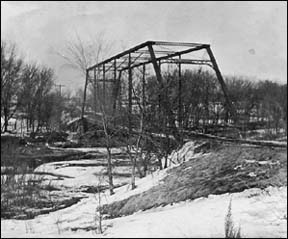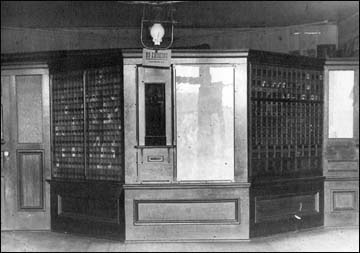
The author, Connie Williams, is doing graduate work in history at St. Cloud State University and has worked at the Paynesville Area Museum for several summers.
 |
(Editor's note: For the next year, we will present a series of articles that examine the years around 1900. Our purpose is to provide a comparison of the beginning of the 20th Century to its upcoming end. The author, Connie Williams, is doing graduate work in history at St. Cloud State University and has worked at the Paynesville Area Museum for several summers.
|
 The first settlements in the Paynesville area were begun in the middle 1850s near the Crow River on what is now the west side of the city. This first Paynesville was the nearest trading center for people to the west in Kandiyohi County. Supplies for the stores were brought here by teams of oxen from St. Paul.
The first settlements in the Paynesville area were begun in the middle 1850s near the Crow River on what is now the west side of the city. This first Paynesville was the nearest trading center for people to the west in Kandiyohi County. Supplies for the stores were brought here by teams of oxen from St. Paul.
Shown is an earlier bridge and gravel road which spanned the Crow River at the west end of Paynesville, where the first town of Paynesville was located.
The reason for the location of the settlement was that one of the best fording spots on the Crow River was just west of the current Paynesville. All settlers traveling through the area used to ford the Crow at this spot (near the present junction of Highways 55 and 23). Consequently, the town became important for furnishing supplies and as a place to pause for rest during the journey.
As people kept migrating into the area, more businesses and houses were built. In the late 1860s and the early 1870s, business places in Paynesville included two stores, a hotel, a post office, a blacksmith shop, a wagon shop, a mill, a hardware store, and a millinery store. Some of the best known businesses were Phipps Store, Tuttles Store, Appelgren Mill, and the Richardson House Hotel. There were also two churches.
The first town was built in a strip around Mill Street. What is now the city of Paynesville was all farm land.
An interesting aspect of Paynesville in those early years is that due to the manner in which the boundaries of the different counties were laid out, Paynesville did not lie within any county at all. It took a special act of the state legislature to make it a part of Stearns County.
Township formed
On May 27, 1858, a meeting was held for the purpose of organizing a town. Seven voters decided to call the township Verndale.
A few years later, the township of Paynesville was taken out of the township of Verndale and organized as a separate township. This occurred on Sept. 20, 1867.
The name Paynesville comes from Edwin E. Payne, one of the first two permanent settlers in the town. He was the agent of the Paynesville Townsite Company, which organized the first successful settlement in the area. Payne was also a justice of the peace in Verndale and served as the first postmaster.
Railroads race to town
In 1887, the first Paynesville was organized into a village, but, by then, the emphasis was switching from river fords to trains. With trains able to carry more than wagons, settlers wanted to live by the train tracks.
Two competing railroads the Soo Line and the Great Northern started to lay tracks into the area. The company to finish laying their tracks first had the right of way for its trains. The loser then would have to schedule their trains so that they didn't interfere with the company who got to Paynesville first.
This spurred competition to get train tracks to Paynesville first.
The town split into factions, depending on whether they supported the Soo Line or the Great Northern. Jim Haines, a landowner and resident of Paynesville, donated a large part of his land to the Soo Line. He hoped the Soo Line would be first and a town would develop near his property.
As the railroad approached Paynesville, every available horse and oxen was employed in construction. Every available farmer was recruited. Work went on day and night. Young boys were hired to hold lanterns for the workers. Huge crackling bonfires were kindled to provide light as ties were laid and spikes driven at night.
In the end, the Soo Line was victorious and many people rallied to the new land donated by Jim Haines and built a town called "Jim Town," or New Paynesville.
Meanwhile, another faction built around the Great Northern railroad, which was called "North Town."
For a time, a very unique situation existed there were three Paynesvilles! Old Paynesville was on the west end of today's city; Jim Town or New Paynesville in the present downtown area; and North Town, where Bork Lumber and Three B Trucking are currently located.
North Town
North Town, or North Paynesville, was nothing but grain fields before the coming of the railroads. Hardly had the railroad gone through when a depot and four grain elevators were built.
Wheat was a big money crop for farmers in those days. Both Jim Town and North Town were the only towns on the railroads for miles in any direction. This made the two towns the natural marketing and storing place for the farmers in the area.
North Town had elevators owned by Cargill, Duluth (or PV), and two owned by independent operators. The two independent elevators would open during the rush of harvest season, but would close during slack times.
Post office
Almost as soon as Paynesville was registered as a townsite in Stearns County, a post office was established by the U.S. Postal Service. In 1857, the town's namesake, Edwin E. Payne, was named postmaster. The first equipment in the new post office was a tea chest and a few wooden boxes.
Paynesville became part of the St. Peter to St. Cloud postal route. In the early days, mail routes were contracted with private parties, who in turn sublet for various parts of the route to individuals.
A.L. Elliot was one of the early mail-carrying subcontractors. He made his trips on foot. On Dec. 24, 1889, Elliott was named postmaster. Because of the rivalry between Old Paynesville and New Paynesville, Elliott moved the post office to a location between the two towns. It stood approximately where Grace United Methodist Church now stands. Years later, he built the first post office in New Paynesville.
Dispute
 In those days, the rivalry was so strong between the towns that letters mistakenly sent to wrong town would not be returned and went undelivered.
In those days, the rivalry was so strong between the towns that letters mistakenly sent to wrong town would not be returned and went undelivered.
The New Paynesville Press of Thursday, May 14, 1891, gave the following account of the post office situation: "The post office department had been kept busy for nearly a year past changing the site of the post office at Paynesville, North Paynesville, and New Paynesville, Stearns County. Finally an inspector inspected the place and made a report recommending the establishment of a new post office at New Paynesville and the continuance of the office at Old Paynesville also.
One of the early Paynesville post offices was located in the building at the corner of Washburne Avenue and James Street now occupied by Sheri's Studio.
"Under this recommendation an office was established at New Paynesville (on) April 17 with George R. Stephens, postmaster. The people at Old Paynesville are now trying to secure the discontinuance of the new post office. It is safe to say that if they continue to act like the dog in a manger, the dog will be killed and only the manger left. For the department will discontinue the office at Old Paynesville and the people have to walk to New Paynesville for their mail, as the latter part has the railroad station and is the best located anyway."
Stephens, the first postmaster in New Paynesville, was also publisher of the New Paynesville Press, so he pushed hard for the development of New Paynesville.
The fighting and bitterness continued. People picked fights with each other on the streets and in stores. They called each other liars.
During the post office broil between Old Paynesville and New Paynesville, the Paynesville News, published in North Paynesville, sided with old Paynesville in their dislike for the post office in New Paynesville. Eventually the Paynesville News was sold to Stephens, who combined it with the New Paynesville Press to become the Paynesville Press.
For 13 years, Paynesville officially had two post offices. The original post office was discontinued on Nov. 15, 1904. On Jan. 27, 1905, the New Paynesville Post Office was officially renamed Paynesville with Elliott as the postmaster. The Old Town post office was subsequently discontinued.
New Paynesville got the post office, and it is now the only Paynesville. It now includes most of Old Paynesville within its boundaries. North Town still has a few businesses, but is no longer a separate town.